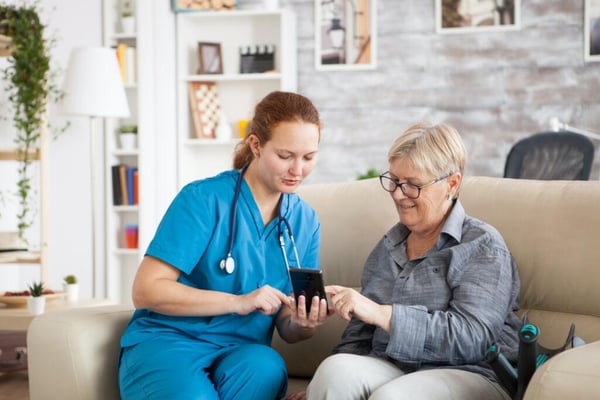For an Outstanding CQC report, you’ll need to be able to demonstrate that your service is safe, effective, caring, responsive and well-led.
In this article, we will look at what Safe means in the context of a CQC inspection. We’ll examine how you can demonstrate that you provide safe care to a CQC inspector, and how you can leverage technology to help you capture and analyse data to help you provide a safer service.
Is the service you provide safe?
Due to the nature of an inspection, your CQC inspectors only get a snapshot of the service you provide at a given point in time. Even the worst services are unlikely to have a serious event occur when the inspectors are visiting, so you will need to be able to evidence that your service is safe for patients in your care, even when inspectors aren’t there.
1. Correct skills for the correct client
It is crucial that you are able to evidence that your staff have the skills to meet the needs of individual clients if you want a high CQC rating. A single place to find digital records which can demonstrate training, skills and experience of staff that you can access confidently and quickly when asked gives reassurance to inspectors and family alike. If, for example, you have a client-specific need such as a learning disability, you want to be able to demonstrate that the staff working with that client are sufficiently skilled to provide the best supportive care.
Induction training is the foundation for shared best practice across the organisation and therefore needs to be clearly recorded. Access to refresher information, policies and procedures, and further training reinforces this effectiveness.
2. Training Records
All training records need to be kept up-to-date at all times to ensure that staff working with your clients are sufficiently qualified to meet their needs and also up to date with best practice. Record a strong training structure from induction and ensure completion of the modules within it. This training should include:
-
Health and Safety
-
Fire Safety
-
Equality, Diversity and Human Rights
-
Infection, Prevention and Control
-
Manual Handling
-
Food Hygiene/Food Safety Awareness
-
Safeguarding Adults
-
Safeguarding Children
Your care management software package can identify when training needs refreshing and can allocate online training packages where required, automatically updating the staff member’s training record as training is completed. In this way, you can demonstrate to your CQC inspector that your clients are in safe hands and that your staff have the training and resources available to them to be able to provide best practice care.
3. Risk Assessments
Risk assessments are an integral part of the care planning process and are there to protect both staff and clients from risk of accidents and injury. Clear risk assessments that are recorded and held against the client record are further evidence of safe delivery of care. Having a digital record for risk assessments means that they are easily reviewed, updated and amended as circumstances change.
4. Rostering
Nothing is more unsafe than leaving extremely vulnerable individuals without a visit when it has been clearly identified that this is needed for their safety, dignity and well-being.
An effective rostering system can allocate the right staff to the right client at the right time. It can also accommodate sudden changes in availability and allocate staff by qualification and location to get help and support to the people that need it when needed. This not only applies to staff absences and reallocation of clients, but also in the event of client illness or injury where additional staff may need to provide assistance at short notice. The flexibility to be able to reallocate staff easily and effectively means that when one of your care workers suddenly has to go to hospital with a client, the remaining clients for the day are safely provided for.
Continuity of care staff and having a regular team to support each individual helps them to feel safe and confident in the care that they receive and also contributes to the feedback that they and their family share with the inspectors.
5. Reports
We have all heard the horror stories of care workers who have claimed to have spent the required amount of time with their clients but instead have either sat outside in their car or not turned up at all. Technology can clearly identifies when the care worker has entered the premises and when they have left means that you can evidence the amount of time spent with the client. Data recorded about checking-in and check-out times can be used during staff supervision and reviewed with the aim that clients have regular time slots that are adhered to whenever possible.
6. MAR Charts
Medication Administration Records (MAR charts) are a vital tool for monitoring the administration or prompting of medication. Electronic MAR charts (eMAR) provide a live record of medication for the office, the care worker, and the family. They can also hold valuable and relevant information, such as foods to be avoided with certain medication. If for any reason, there are concerns about missed or overdosed medication, the details held within the eMAR can be shared with the appropriate pharmacist or healthcare professional (provided the correct sharing permissions were recorded as part of the client sign-up process).
7. Policies and Procedures
The digital storage of policies and procedures makes them easily accessible to care staff, whether in the office or with clients. These policies should include such items as a whistle-blowing policy which further enhances the evidence of safety and the management’s open approach to safety and improvement.
8. Secure Data Storage
To be compliant with GDPR, we need evidence that all personal records are kept securely and only shared with those that have the correct permissions and authority. Personal data belongs to the client, and they have the right to request the removal, amendment and deletion of their records. In a digital process, this is easy to do and record that this has been done. Data sharing permissions can be part of the initial sign-up process.
Nursebuddy understands how a good CQC rating impacts your business, therefore we’re producing an article series with in-depth information on how you can improve your CQC rating by making use of technology. Look out for our next article – Is the service you provide effective?
Nursebuddy is a care management software with a mission to help care managers and staff like you save time on paperwork and more time growing your business. Book a demo with us and we will tell you more about how we can help you.




